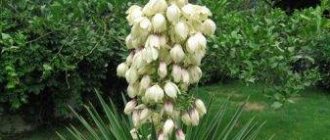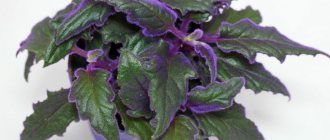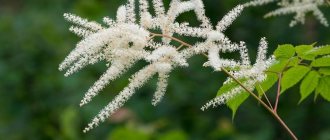Cloves - types and varieties
Carnations are distinguished by their rare diversity and number more than 250 species, subspecies and many varieties. The varieties used in floriculture are very decorative, quite unpretentious and are often grown as annual and biennial plants.
Some small-flowered, low-growing species - grass, sandy, needle-leaved, glaucous, some varieties of pinnate carnation overwinter well in the ground and are grown as perennials.
Turkish clove
The Turkish or bearded carnation is perhaps the most favorite type of this wonderful plant, grown in a two-year cycle. Bright, persistent flowers appear already in June, decorating flower beds, when the summer flowers have not yet entered into full force. The color palette of varieties and hybrids of Turkish carnations is extremely diverse - from fawn tones (pale pink, white, cream) to the most beautiful bright single-color and multi-color varieties.
Heimatland
Turkish carnation variety Heimatland
The spectacular variety is valued for its early and long flowering - the buds bloom already in May, the bushes remain decorative until the end of July. The plants are powerful, 50–55 cm high, the leaves and shoots are dark green with a characteristic burgundy tint. Inflorescences up to 12 cm in diameter are composed of flowers with serrated dark red petals and white eyes. Flowering is long, the plants are stable, and do not lose their decorative appearance in rainy weather.
Lahskenigin
Another early-flowering variety grows as a compact bush up to 45 cm high and 35–45 cm in diameter. Green shoots and leaves are decorated with large flowers with a diameter of 2.0–2.2 cm, collected in round inflorescences. The petals are dense, with a finely toothed edge, and a brilliant salmon-pink color. Flowering is abundant - from mid-May to the end of July.
Schneeball
A reliable ancient variety with exceptionally pure white petals. Medium-sized plants reach a height of 35–40 cm, forming rounded bushes up to 45 cm in diameter. Lush inflorescences, 10–11 cm in diameter, consist of large snow-white double flowers with a jagged edge. The variety blooms in June-July.
Features of care
Garden carnations are not capricious and are easy to “give in” even to novice gardeners. Each of the varieties has its own characteristics of planting and care - perennial Turkish and Chinese carnations, for example, are considered the most hardy, shabot carnations, on the contrary, are more demanding. The basic rules of agricultural technology are the same for all types.
Watering and fertilizing
Garden carnation needs regular but moderate watering. Young bushes are watered once a week. Adults generally have enough natural precipitation; during drought they are watered several times a month. After watering, the soil around the bushes is loosened.
Caring for garden cloves involves regular application of fertilizers. A couple of weeks after planting in open ground, the bushes are fed with complex additives with a predominance of nitrogen, for example, nitroammophos. At the end of May and beginning of September, fertilizers with a high content of phosphorus and potassium are applied. Make sure that the mixtures do not contain chlorine.
Trimming
Annual garden carnation branches well. To form a lush bush, it is enough to pinch it once at the time of picking. In summer, care comes down to removing faded buds. Perennial carnations are additionally pruned after flowering, leaving 10 cm “stumps”.
Preparing for winter
Perennial carnation tolerates frost well. In autumn, the bushes are pruned and hilled. The ground around is mulched with sawdust, straw or fallen leaves. To prevent the mulch from being blown away by the wind, it is “pressed down” with branches.
Chinese carnation
A perennial herbaceous plant native to China and grown as an annual crop. Of the numerous subspecies in home gardening, the most common is the Chinese carnation Heddeviga. The plants are small, with beautiful flowers of various colors, double and non-double, often with intricate patterns, with virtually no aroma.
Mary
Chinese carnation variety Mary
A cheerful variety with rounded bushes up to 25 cm high and rich green shoots hidden under flowers at the peak of decorativeness. The flowers are 4 cm in diameter, simple, with a feathery edge of the petals, bicolor - the carmine-red center stands out brightly against a delicate white-pink background. Blooms from early July until severe frosts. The variety is suitable for flower beds and potted plants.
Vesuvius
The popular variety is characterized by rounded bushes, 25–30 cm high, with elongated green leaves and a burgundy tint at the shoot nodes. The flowers are 6–7 cm in diameter, densely double, fiery red, very rich in color, with a jagged edge. Flowering from early July until severe frosts. This is one of the most beautiful red varieties of Heddevig's carnation.
Schwarzer Prinz
The dark-colored inflorescences of the Black Prince look stunningly impressive. The bushes are compact, 22–25 cm in diameter, with green leaves and shoots with a brownish tint at the nodes. The flowers are densely double, 5–6 cm in diameter, dark burgundy, almost black, with a bright white border along the jagged edge of the petals. Blooms from mid-June until autumn frosts.
Dutch carnation (garden)
Dutch carnation (garden)
Under the name garden or Dutch carnations, extensive breeding groups of perennial plants are united, the most common of which are Margaret, Grenadine and Chabot.
Carnations of the Margaret are characterized by remontant flowering, which lasts continuously throughout the season. Beautiful plants 40–50 cm high, dotted with fragrant flowers in white, yellow or red tones with delicate, deeply dissected petals.
Representatives of the group bloom well after transplantation; they are dug up in the fall, decorating greenhouses and winter gardens in late autumn and winter. Margaret's group does not stand well in the section, so it is not used for these purposes.
Grenadine group of carnation varieties is characterized by powerful bushes up to 60 cm high, with narrow bluish leaves, pleasantly smelling double or simple inflorescences of various colors. One of the advantages of this perennial carnation is the possibility of successful wintering in mild winters, for which the plants are covered with spruce branches or other available materials in the fall.
The most famous varieties are:
- Schneeflocke with snow-white flowers;
- Rosakenigin (Rosakenigin) with flowers of a deep pink tone;
- Morenkenigin (Morenkenigin) with dark, burgundy-red inflorescences.
And yet the most famous representative of garden carnations is the lush beauty Shabot . This group includes remarkably decorative varieties and hybrids in a huge selection diversity.
Diseases and pests
Garden carnations are little susceptible to disease, but the occurrence of infection is favored by very high humidity, fluctuations in air temperature, and excess nitrogen. If weeds are not eliminated, they will become objects of distribution of fungal spores, viral infections, and bacterial rot. Symptoms of a fungal disease: the appearance of light-colored spots on the leaves at first, then brown spots with a scarlet border. The plantings are treated with fungicides Fundazol or Topaz.
Carnation pests - spider mites - cover the lower part of the leaves with a thin net. Thrips infestations show up as silvery-white spots on leaves and flower buds. Aphids suck sap from the most tender parts of plants; they become pale grassy, often covered with mucus. For parasites they are treated with biological insecticides: Fitoverm, Vertimek. You can spray with solutions of Aktara and Actellik.
Carnation Shabo
Spectacular plants are distinguished by rather large bushes, the brittle shoots of which are covered with greenish-gray narrow leaves and decorated with fragrant large flowers, single or collected in inflorescences. To preserve varietal properties, vegetative propagation by cuttings is used, by digging in the uterine bushes in the basements in the winter. You can read more about growing Shabot carnations in the article “Shabot carnations.”
Champagne
Carnation Shabot variety Champagne
A very beautiful, joyful variety with double golden-yellow flowers 5–6 cm in diameter, emitting a delicate aroma. One bush produces about 20 flowers per season. Plants up to 50 cm high, with erect shoots suitable for cutting. Flowering is long - from June to October. In autumn, carnations are dug up, planted in flowerpots and decorated with cold verandas.
Mikado
The bushes are slender, up to 60 cm high, with graceful green shoots and narrow leaves, with a characteristic purple tint in the internodes. The flowers are large, very double, silky in texture, rich violet-lilac in tone with a finely toothed edge. Propagation by cuttings, flowering from late June to September-October. The variety looks great when cut.
Aurora
Carnation Shabo variety Aurora
Erect bushes with long shoots up to 65 cm high, green in color with a bluish bloom. The inflorescences are full, round, densely double, with gentle transitions of tones from salmon to light pink. The petals are dense, the edges are finely toothed. One of the best pink varieties is quite cold-resistant and will decorate flower beds until October. Plantings of this pink variety are very decorative and look luxurious next to the purple Mikado flowers.
Zhanna Dionysus
Large boiling-white flowers with delicate wide petals, the shape and fullness of the inflorescences are more similar to small peonies. The bush is medium in size, with strong shoots up to 50 cm high and narrow lanceolate leaves of dark green color. The flowers are lush, up to 8 cm in diameter, double or semi-double, great for cutting. This wonderful white variety is hardy and can withstand cold and dry periods.
feathery carnation
A low-growing species that grows in poor soils in the mountainous areas of northern Europe. Cushion-shaped bushes with long, needle-like leaves and pink or white flowers are essential in garden design. Hardy plants, which are accustomed to cold winters with little snow, overwinter well in open ground.
Double Rose
Feathery carnation variety Double Rose
Neat round bushes 25–30 cm in height and diameter, covered with dark green elongated leaves. Against this background, the shining pink color of double inflorescences looks bright and very attractive. The terry nature of the flowers is further enhanced by the feathery fringed edge. The variety blooms at the beginning of summer and blooms until the end of July. The frost-resistant plant overwinters well with light shelter.
Haytor White
Feathery carnation variety Haytor White
This exquisite variety forms dense clumps 20–30 cm high and up to 40 cm in diameter. In spring, the color of the shoots and elongated leaves is gray and eventually becomes green. In June, the bushes are covered with snow-white double flowers with a fine-toothed edge, similar to needles of frost. Flowering lasts until the end of July, but even later the compact green plants retain their decorative properties.
If you decide to grow this type of carnation, we advise you to read the article “Feathery carnation“.
Planting seedlings in open ground
Seedlings are planted in open ground after the ground has warmed to 15 degrees. It is easy to establish this moment by the blossoming of the apple tree. More precise dates are determined based on the climatic characteristics of the region - if there is a threat of return frosts, it is better to wait with planting.
The planting holes are prepared in a few days: sand and drainage are placed on the bottom and watered. The depth of the holes should be such that the seedlings do not have to be buried, but at the same time the root system is completely underground. The distance between them is set based on the size of the variety. Low-growing ones, such as lilipot, are planted 15-30 cm apart; for tall ones, 40-50 cm are set aside.
The seedlings are hardened off over several weeks, gradually increasing the time spent outdoors. A cloudy day is chosen for landing. The seedlings are carefully removed from the containers, trying not to damage the root system. Place the ball of earth into the holes without shaking it off, cover it with soil, compact it and water it abundantly. For several weeks, until the seedlings take root, it is not advisable to allow the soil to dry out.
Sand carnation
Unlike the previous species, the birthplace of the sand carnation is the Mediterranean countries. Herbaceous perennial plants form a dense turf with pink and white peduncles up to 30 cm high, prefer sandy loam, are unpretentious in care, frost-resistant and drought tolerant.
Nostalgia
Sand carnation variety Nostalgia
The compact bush is formed by short, densely leafy shoots of a bluish-green color. On slender peduncles up to 30 cm high there are simple-shaped white flowers with a cream center. The petals are strongly dissected, with a long thin fringe. The variety blooms very profusely, in June-July, and is characterized by a strong, pleasant aroma.
Sea foam
Dense bushes, growing in width year after year, do not grow more than 15 cm in height. The stems are branched, the leaves are clear green. White fragrant flowers are small, five-petal in shape, up to 2.5 cm in diameter. The edges of the petals are finely cut, fringed. Blooms for a long time, from mid-summer to early autumn. Used for rocky slides and border design.
Dianthus grass
Fans of alpine slides are well aware of this wonderful species, loved for its compactness and unique decorativeness. Plant height is no more than 15–20 cm, shoots are knotty, thin, creeping. Small, exquisitely shaped flowers are painted in colorful, pure shades.
Flowering is extremely generous and long - from mid-May to October with short breaks. Spectacular bushes are literally doused with bright flowers all season, invariably attracting the eye.
Confetti Deep Red
Plants with long shoots form spherical bushes up to 15 cm high. At the end of the peduncles in May, deep red single flowers with a darker center appear. The name of the variety perfectly conveys the appearance of flowering bushes, as if sprinkled with deep red confetti. The variety does not tolerate stagnant water and does well on light soils.
Diamond
Carnation grass variety Brilliant (Brilliancy)
Another luxurious herb variety with red flowers. Plant height up to 25 cm, branching stems, tend to take root in internodes. Leaves and shoots have a thick bluish tint, especially at the beginning of the season. Flowers up to 1.5 cm in diameter with split edges and a juicy carmine-red tone with a crimson tint. Flowering is abundant, from June to early September. Diamond looks good in rockeries or when planted in small groups on lawns.
Landing
Planting and subsequent care of perennial garden carnations is not a difficult task, and even a novice gardener can handle it. Seeds for seedlings are planted around March in a large container or peat cups.
Many garden varieties are perennial, but in our cold climate they are grown as biennials for no longer than two seasons. For the same reason, propagation by seedlings is recommended - the seeds are usually sown in mid-May, and flowering will begin only in the second season.
- Planting seedlings from containers in open ground in open ground is done together with a lump of earth around the roots of the bush, this protects the roots from damage, and the native soil smoothes out stress from new conditions.
- Holes are pre-prepared 5 centimeters deeper than the lump of earth will be. At a distance of about 20cm from each other. At the very bottom of each hole add sand mixed with compost 3 centimeters thick.
- After placing the seedlings in the hole, it is sprinkled with a little earth and gently pressed down.
- The seedlings are watered a little and the soil is lightly mulched.
Important
At the time of planting, the average temperature during the day should no longer be below 15 °C
Selection of capacity
There are no strict requirements for the capacity, the main thing is that it is large, but not very deep. A regular plastic container or cardboard box works well.
After picking, the sprouts will need to be transplanted into separate pots or peat tablets, in which case they may be smaller but deeper.
Seed selection and preparation
When you come to the store to buy seeds, carefully inspect the packaging; there should be no damage to it. They may indicate that the seeds were transported or stored incorrectly, this leads to damage to the planting material, and bad material will not produce beautiful flowers.
Before planting, he recommends disinfecting the seeds; to do this, it will be enough to soak them in a solution of potassium permanganate for 15-20 minutes. Disinfection can avoid any diseases.
You can also treat the seeds with immunomodulators, they strengthen the plant’s immunity.
When purchasing a package of seeds, check for recommendations on the back; there should also be information about the manufacturer.
Soil preparation
Soil for carnations can be bought in the store; universal soil for flower crops is suitable for it. But you can do it yourself, for this you will need:
- River sand, it must be washed;
- Turf land;
- Peat;
- Humus.
Make sure that the soil is light and loose; it should allow moisture and air to pass through well.
Carnation glaucous (grayish blue or caesius)
Cushion-shaped curtains of gray carnations with long thin leaves do not exceed 20–25 cm in height. The color of the leaves and shoots is gray, then becomes rich green. The flowers are small, on tall peduncles, bloom brightly in June-July. The frost-resistant species overwinters well on the site, but it is better to cover the turf raised above the ground with spruce branches.
Badenia
The height of the plants is no more than 25 cm, adult bushes reach 50 cm in diameter. The leaves are bluish-green, losing their bluish bloom during the summer. The flowers are quite large - 2.5–3 cm in diameter, silky, catchy raspberry-pink in color, fragrant. The petals are wide, with a serrated edge. Flowering is abundant, from late June to early August.
Pink Blanca
Gray carnation (grayish-blue) variety Pink Blanca
A rounded bush with dark green leaves with a bluish bloom, at the peak of its decorativeness, is completely covered with flowers, turning into a fragrant pink cloud. Plant height 22–25 cm, diameter 40–45 cm. The flowers are incredibly showy, sparkling pink-lilac in color with a lighter center. The petals are shallowly cut along the edge, fragrant, silky. Flowering from mid-June to late July.
Reproduction by cuttings
All types of perennial carnations are propagated by cuttings; this method is not suitable for annual plants. Cuttings are selected from among well-developed vegetative shoots at the end of May. The length of the cutting should be from 3-9 cm, and the shoot should have at least 6 healthy leaves.
Cuttings of eustoma and carnation
The shoot is cut from the stem under the node using a sharp pruner and the leaves are removed from its lower part. An incision is made along the stem.
The cuttings are placed in a pot with perlite and covered with a jar. If the greenhouse is made correctly, rooting will occur within 3 weeks after planting. Next, you need to prepare a container with calcined sand or perlite and plant the cuttings in it.











